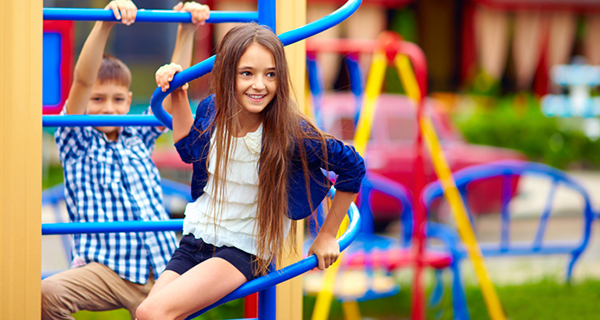
Tribal governments: Use these playground safety tips to protect your children
More than 200,000 children visit the ER every year because of playground injuries. Remember how it felt to be a kid: bold, fearless, and able to leap tall buildings in a single bound, only to face-plant in the dirt? While we can’t control our children’s actions from afar, we can make sure that their playground is safe. Use this article as a checklist of playground safety on your tribal lands.
Top 10 Checklist for Playground Safety
(provided by the National Safety Council)
1. Surfaces around playground equipment should be filled with at least 12 inches of loose fill. Avoid concrete, grass or dirt surfaces. Instead, use wood chips, bark mulch, wood fibers, sand, pea gravel, shredded tires or rubber mats, because these cushion falls well. After all, nearly 79 percent of playground injuries are caused by falls to the ground. Regular maintenance is also crucial; if not daily, then at least monthly.
2. Stationary equipment should have at least a six-foot use zone in all directions. That means your loose fill should surround the equipment in a six-foot perimeter. See below for a more in-depth discussion on specific playground equipment.
3. Any openings that can trap children, such as in between guardrails or ladder rungs, should be less than 3.5 inches apart or more than 9 inches.
4. Guardrails should surround all elevated platforms and should be at least 29 inches high for preschoolers and 38 inches high for school-age children.
5. Remove or repair any exposed concrete footings, tree roots or rocks that could trip children.
6. Check for sharp edges and dangerous hardware, like open “S” hooks or protruding bolts.
7. Playgrounds should be maintained regularly. Post signs with a phone number to report any problems.
8. Delineate age-appropriate equipment. Equipment that’s safe for school-age children may not be safe for preschoolers. If possible, provide separate areas for toddler and pre-school equipment versus that for school-age children. The areas can be delineated by landscaping or benches. This can keep older children from running through the younger areas and causing injury. It will also hopefully underscore to parents the importance of choosing which equipment their children can use, according to their ages.

Information courtesy of U.S. Consumer Product Safety Commission’s Safe Playground Handbook
9. Post signs reminding parents that children must be supervised while they play, along with other playground safety tips.
Choosing and maintaining equipment for playground safety
Swings are the mobile playground equipment most likely to cause injuries. Swings should be set far enough away from other equipment so that children won’t be hit by a moving swing. Only two swings should be in each supporting framework, and they should be at least 24 inches apart.
Replace metal or wooden seats with soft seats. Because animal swings have caused several deaths, they should be removed from playgrounds. Full-bucket seats are recommended for younger children; half-bucket seats are dangerous because babies and toddlers can slide out of them.
Slides should be well-anchored, have firm handrails and good traction on the steps. There should be no gaps between the slide itself and the platform. Be sure there’s a bar at the top of the slide, so that children must sit before they go down.
Spring-loaded seesaws are best for young children. Avoid adjustable seesaws with chains because children can crush their hands under the chains. A traditional type seesaw should have a tire or similar object under the seat to keep it from hitting the ground.
Merry-go-rounds, also called “whirls” or “roundabouts”, are best for school-age children. They should have good hand grips. The rotating platform should be level, free of sharp edges and have adequate ground clearance to prevent crushing or severing limbs.
Monkey bars and climbing equipment, while great for developing upper body strength in older children, provide a danger for kids age four and under. More children are injured falling off climbing equipment or horizontal ladders than anything else on the playground. In fact, 40 percent of all playground injuries are related to climbing equipment.
Equipment not recommended. The following playground equipment is not recommended for use on
public playgrounds:
- Trampolines
- Swinging gates
- Giant strides
- Climbing ropes that are not secured at both ends.
- Heavy metal swings (e.g., animal figures) – Their heavy rigid metal framework presents a risk of impact injury.
- Multiple occupancy swings – With the exception of tire swings, swings that are intended for more than one user are not recommended because their greater mass, as compared to single occupancy swings, presents a risk of impact injury.
- Rope swings – Free-swinging ropes that may fray or otherwise form a loop are not recommended because they present a potential strangulation hazard.
- Swinging dual exercise rings and trapeze bars – These are rings and trapeze bars on long chains that are generally considered to be athletic equipment and are not recommended for public playgrounds.
For a more in-depth treatment of this subject, including how to choose the site for a new playground, view the U.S. Consumer Product Safety Commission’s Safe Playground Handbook.
